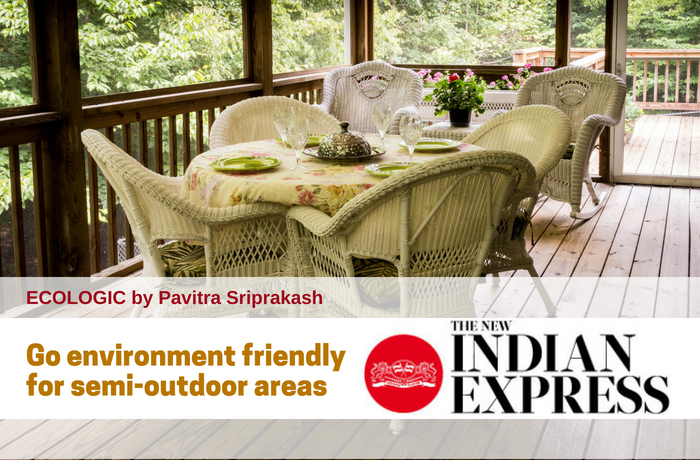25-Aug-2018:Pavitra Sriprakash, Director and Chief Designer, Shilpa Architects Planners Designers Pvt. Ltd. writes a weekly column on Sustainability for The New Indian Express titled “ECOLOGIC”. This week’s article highlights the use of environment friendly materials for semi-outdoor areas.
Read More: Link to article on The New Indian Express page
Full Text:
“What is a good material to consider for an outdoor deck?” asked a client building a home with many courtyards and verandahs. This got me thinking about sustainable building options for semi-outdoor areas. Typically, these are extensions of the interiors, and interior floor tiles or stone is commonly used.
It is important to know that fundamental to good architecture is the building’s orientation which depends on the latitudinal location of a site, For instance, some poorly oriented terraces and mislocated balconies can be used only during nights and early mornings as they become hot areas to avoid during the day. Similarly the proportions of a verandah or a courtyard controls the interiors’ daylight and thermal comfort.
Wood is a poor heat conductor and will not reflect the radiative heat into living spaces. The recent trend shows a preference for having wood floors for these decks, verandahs and semi-outdoor spaces as they are stylish. Being expensive, wooden flooring in these areas is difficult to consider for many.
Wood is also a great and versatile material, but its usage in the building industry in India is restricted due to forest department rules for felling of trees. There are no “cultivated” forests for logging and using wood forces clients to import an expensive material. Sourcing suitable hardwood from far away places also makes them a bad choice from the sustainability perspective. So, what alternative can be considered that acts, looks and feels like wood, is sustainable and affordable?
The answer could be Wood Plastic Composites (WPC). WPC deck boards are manufactured from a combination of plastic and wood or cellulosic materials. In many cases, the wood component comes directly from post-industrial manufacturing of wood products, like furniture factories. The byproduct of the furniture industry becomes the raw material for WPC. They reduce waste from first use and divert the bio-based materials from landfills to downstream factories. Using waste from one building material manufacturing factory in another building product is an excellent example of a circular green economy.
Production of composite decking typically requires much less energy than harvesting, transporting, and processing natural wood decking materials. Composite deck manufacturers can greatly reduce inbound transport impacts. After all, the source wood material has already been logged, shipped and converted; and using a byproduct takes advantage of the original embodied energy.
Durability is another key measure of sustainability, and any product has a higher rating if no extra materials are required for maintenance, or if the lifecycle of an original raw material is lengthened. Every extra year of use minimises the environmental footprint. Wooden decks require onsite coats of sealing chemicals to prevent early rot and decay. Composite deck boards perform well when compared to real wooden decks on this quality of sustainability.
Some of the pitfalls of the material however include the poor performance in case of fires, lower mechanical strength and stiffness, and the fact that they experience temperature-dependent behaviour over time. While performing well against rot in general, the wood particles within the WPC are susceptible to fungal attack.
When making the decision for a deck system that is a green, environmentally-savvy and planet-conscious, do well to check out WPC as an alternative to wood.
Pavitra Sriprakash
Twitter @pavisriprakash
The writer is an architect, urban designer, dancer and chief designer at Shilpa Architects



